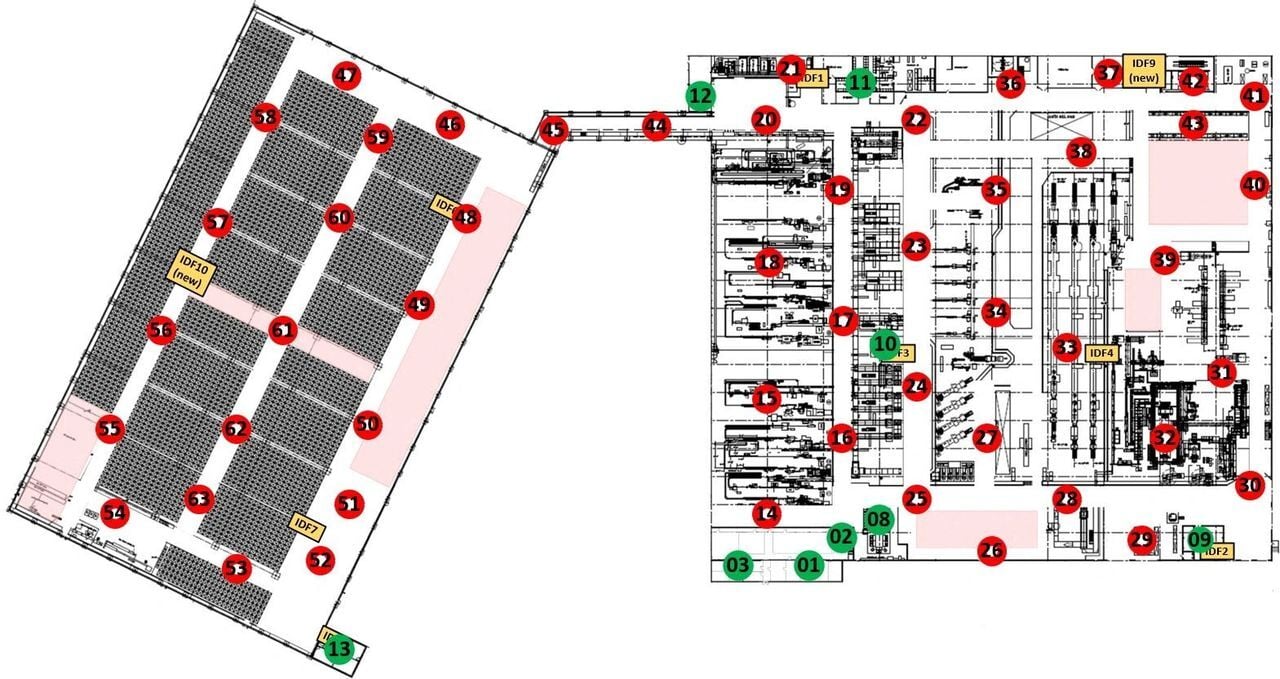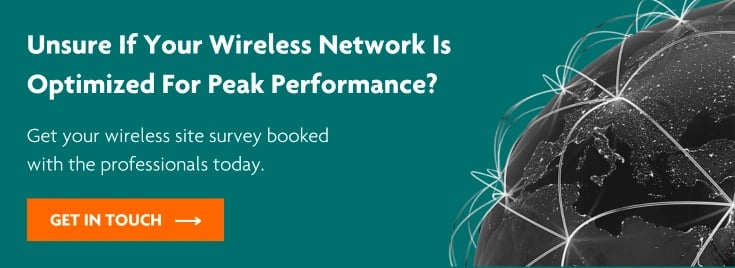
Robust Wi-Fi Network Installation in California, USA
Wi-Fi is often the most prominent and frequently criticized component of any modern network. When it operates smoothly, it goes unnoticed, but when it malfunctions, it quickly draws attention. Establishing a dependable Wi-Fi network involves more than just installing access points on a ceiling and expecting optimal performance. It requires a comprehensive understanding of RF behavior, careful interference management, and a precise balance between capacity and coverage.
Critical Findings from Pre-Deployment and Wired Surveys
Wireless Coverage Optimization
- Total facility area surveyed: approximately 400,000 sq. ft. necessitating multiple strategically positioned Access Points (APs).
- Rigorous evaluation of signal strength and coverage areas highlighted several key locations prone to dead zones requiring targeted remedial action.
- Coverage and dead zones were identified, highlighting the need for improved coverage, particularly in warehouse storage and production areas.
Signal Strength & Interference Mitigation
- Minimum acceptable Received Signal Strength Indicator (RSSI): -65 dBm; Signal-to-Noise Ratio (SNR) maintained above 25 dB for optimal connectivity.
Structured Wiring and Fiber Infrastructure
- Deployment preference for Category 6A cabling to uphold the integrity of high-speed data transmission within recommended distances.

Significant infrastructure enhancements:
-
Replacement of existing Cat5 and Cat5e cables with Category 6A standards.
-
Infrastructure optimization involved replacing outdated MDF/IDF racks and optimizing power distribution.
-
Installation of new Single Mode (SM) fiber optic cables interconnecting MDF and multiple Intermediate Distribution Frames (IDFs) locations to ensure resilient backbone connectivity.
-
Fiber backbone implementation involved installing 12-strand single-mode fiber to enhance network redundancy and speed.
Detailed Installation Methodology
After the strategic pre-installation planning phase, which involved analyzing pre-deployment survey data using Ekahau Pro-generated heatmaps and procuring essential network hardware, the next step is the physical installation and structured wiring process. Once the structured wiring is verified, the installation phase begins, encompassing physical mounting, configuration, and validation procedures.
Physical Installation Process
-
Employ trained technicians to safely pull Category 6A cables, meticulously following pre-determined routes that mitigate interference.
-
Utilize scissor lifts for safe and efficient access to elevated installation points, particularly within warehouse environments up to 41 feet.
-
Ensure systematic labeling of cables at both ends for accurate identification and ease of future maintenance.
-
Install new single-mode fiber optic strands precisely between MDF and IDF locations, ensuring optimal data transmission over longer distances.
-
Precisely drill and install mounting brackets and fixtures on drop ceilings for Access Points in administrative office areas.
-
Securely attach AP's and Omni-directional antennas to I-beams, conduit supports, and open iron frameworks in production and warehouse areas, ensuring proper orientation for maximum coverage.
Rigorous Configuration and Network Testing:
-
AP configurations with transmit power standardized at 11 dBm across both 2.4 GHz and 5 GHz frequency bands.
-
Distinct SSID segmentation to facilitate seamless and secure network interactions across corporate, guest, and IT systems.
-
Execution of extensive real-time connectivity validations employing continuous ping testing methodology across critical facility zones.
Step-by-Step Installation Process
1. Pre-Installation Planning
-
Assessed site survey data to determine optimal AP placement and cabling routes.
-
Procured necessary hardware, including Cisco switches, APs, and structured wiring materials.
-
Ensured compliance with safety and security protocols.

AP Placement map detailing access point positions, for optimal wireless network coverage in office production and warehouse.

Structured Wiring and AP Placement Diagram illustrating access point locations, Cat6A cabling paths, and Single-Mode fiber routes connecting MDF and IDF closets, enhancing network reliability and performance in office production and warehouse.
2. Physical Installation
-
Deployed structured wiring, ensuring all cabling adhered to industry standards.
-
Installed access points at strategic locations, optimizing coverage for both 2.4GHz and 5GHz bands.
-
Implemented redundant fiber uplinks to guarantee uninterrupted data flow.

3. Configuration & Testing
- Configured SSIDs, VLANs, and QoS policies for seamless traffic management.
- Conducted wireless heatmaps and performance benchmarks to validate installation success.
- Ensured seamless integration and transition with existing IT infrastructure.
Conclusion
A well-executed network installation is a strategic investment that enables your industrial facility to boost operational efficiency, improve communication, and increase productivity. By utilizing thorough pre-installation surveys, accurate infrastructure deployment, and extensive testing methods, organizations can proactively address connectivity issues and minimize downtime, ensuring a dependable and robust network performance.
In addition to the immediate advantages of stable and reliable connectivity, a well-planned installation offers a scalable framework that can adapt to future technological advancements and expansion. As technology evolves rapidly, the ability to seamlessly incorporate new solutions into your existing network infrastructure becomes essential.
Consistent evaluations, routine maintenance, and proactive adjustments are crucial for maintaining peak performance over time. By being vigilant and adaptable to evolving operational needs and network conditions, you ensure your facility retains a competitive edge and achieves operational excellence in an ever-more connected industrial environment.
In the end, dedicating resources to careful network design and professional installation provides lasting benefits, enabling your organization to prosper and tackle future connectivity challenges with confidence and dependability.
Please get in touch with the experts at Orion US today.

Image Source: Canva
